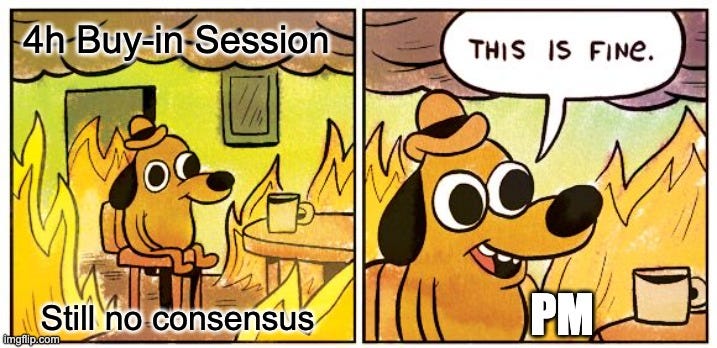The Product Manager in the Middle: When There Are Too Many Cooks in the Kitchen
Navigating egos, opinions, and chaos to craft collaboration and drive outcomes.
Inês Pinheiro-Kumar is back with the next chapter in her series, The Product Manager in the Middle. This time, she’s tackling a situation every PM dreads: When There Are Too Many Cooks in the Kitchen.
If you’ve ever found yourself juggling conflicting opinions, oversized egos, and endless debates, this one’s for you. Inês dives into the reality of balancing alignment with compromise—and why both are essential tools in every PM’s arsenal.
Missed the first episode of this series? Check out 👉 The Product Manager in the Middle: Converging, Diverging, Not Working.
As a Product Manager, alignment, stakeholder management, and driving consensus are part of the job description. However nothing truly prepares you for the reality of juggling everyone’s opinions, ideas, and yes—their egos. You quickly realize that compromise isn’t a nice-to-have; sometimes, it’s the only way forward.
Communication weighs the heaviest on the PM’s keychain
Most of us don’t come into Product Management as strangers to communication. I came in after stints in Business Development, Account Management, and Product Operations, where I’d gotten pretty good at talking to people across different functions. Back then, these conversations were usually insightful, and they almost always gave me the full picture on a topic. Those were the good old days, and, honestly, I miss them sometimes.
Because once you step into the PM role, the fun of chatting with different functions often turns into refereeing between them. I’ve yet to meet a PM who says their favorite part of the day is sitting in a room while everyone’s passionately fighting for their “right” solution. Most of us leave those meetings with a deep sigh, a migraine, and the urge to find the nearest rage room.
Yet, in the middle of all this, there’s a certain satisfaction in pulling together everyone’s perspectives into a solution that (mostly) works for everyone. This is the magic of Product Management: you take in all the noise and somehow turn it into a song everyone is willing to sing. But let’s be clear—driving consensus is only part of the game. The rest is all about keeping communication flowing, taking people’s input seriously, and mapping out the problem space in a way that doesn’t leave anyone behind.
When the P in PM involves Psychology
So, what happens when you just can’t get everyone on board?
This is where PM work requires you to put on your psychology lenses. Understanding why people react a certain way—and, just as importantly, not taking it personally—is half the battle. Every person you deal with feels like an expert in their domain (and to be fair, they are), but this often means they come with a bit of tunnel vision. It’s human nature, and also, ego - which is not intrinsically a negative thing.
For me, it helps to pause and check in with myself: Have I really done everything possible to get this group on the same page?
Did I back my proposal with solid data, framed in a story that resonates?
Did I genuinely address everyone’s input, even if just a bit?
Have I done my research thoroughly?
Did I take time to talk to any resistant stakeholders separately, to really understand where they’re coming from?
Even if the answer to all the above is yes - not time to throw in that towel just yet! If I’ve done all of the above and I’m still met with blank stares or a hard “no,” it might be time to consider the C-word: compromise.
No shame in calling in the reinforcements
Sometimes, we call it “Strategic Compromise”. I once had a drawn out disagreement with someone in a much higher position who just wouldn’t accept my approach. The debate got so intense that it eventually escalated to shouting. There I was, doing my best to calm things down, but consensus was nowhere in sight. In the end, I had to enlist a couple of trusted colleagues to mediate, and we arrived at a compromise.
These situations aren’t fun, but they’ve taught me that compromise isn’t a defeat. In big organizations, pure consensus can be nearly impossible. And that’s fine; it’s part of the game. Sometimes, it’s about making strategic choices that keep things moving forward.
However, there are still key points to keep in mind when you decide to settle for a compromise:
Show respect for everyone’s input and acknowledge that if the compromise doesn’t go as planned, you’ll own it.
Blend their concerns in where possible—sometimes just a bit of goodwill can go a long way.
Don’t hesitate to call in reinforcements if things hit a wall again. Sometimes, a bit of seniority can ease tensions and help bring alignment.
Interestingly, compromise today can make for smoother roads tomorrow. When people see that you’re willing to adapt and that your approach ultimately leads to good results, they’re more likely to trust you next time around.
A Final Reflection and Takeaway
In product management, alignment is the goal, but compromise is often the reality. Real influence isn’t about “winning” every debate—it’s about balancing empathy with decisiveness and knowing when to stand firm or yield. Compromise isn’t giving up; it’s strategy. When used right, it builds trust and sets the stage for real collaboration. Every tough decision, every buy-in, strengthens not only your product but your leadership.
Do: So aim for alignment, tap into your inner psychologist, and don’t be afraid to use compromise as a tool.
Don’t: Get stuck when you cannot reach consensus and remain frozen while waiting for the situation to solve itself.
Curious about how it all started? Don’t miss The Product Manager in the Middle: Converging, Diverging, Not Working—the first episode in this insightful series.






While I agree a compromise is sometimes ideal, in my experience there's nothing worse than being the PM who's refereeing between two parties who disagree.
With no control of the flow or the ultimate decision, you risk becoming a middle person who's trying to get everyone on board an idea that nobody hates and nobody loves. Also decision making by consensus or committee eats up so much time, you won't have achieved anything after months of infighting, by which time the right timing has probably passed you by.
You really need:
A) a view on the right step forward
B) someone (probably quite senior) to step in and say we commit to step 1
C) an agreement to assess our next steps based on customer feedback or data
That's my view anyway!
Very well said Vincent - and totally agree with you on your POV! Leaving the discussion to stew over for a long time can lead to a lot of lost opportunities. Sadly, I'd say from experience, it is a rather common occurrence if you work in bigger organizations where it is not easy to fully control the process on your own.
As I mentioned in the article, at some point you do need someone quite senior if you reach that level of standstill in the buy-in phase - however, I'd say that should really be the last resort as it can strain the stakeholder relationship quite a lot.
Thank you so much for sharing your insights on how you deal with these challenges!